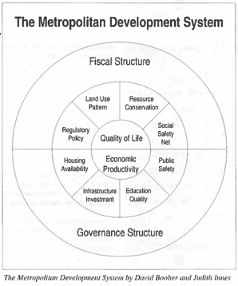By David E. Booher & Judith Innes. David Booher is a Sacramento based planner and policy consultant. Judith Innes is Director of the Institute for Urban and Regional Development at the University of California, Berkeley.
“Efficient firms cannot function for very long in inefficiently configured metropolitan regions.”
Richard H. Mattoon, Fed. Reserve Bank of Chicago

Judith Innes
"Efficient metropolitan land use patterns are closely linked to competitiveness and productivity in regions across the country."
Growth, Efficiency, and System Performance
The message is coming from many quarters of the business community: Efficient metropolitan land use patterns arc closely linked to competitiveness and productivity in regions across the country. The promise: such land use patterns are essential to assuring a high wage, high productivity future.
Successfully meeting this challenge requires a recognition that metropolitan growth patterns and business efficiency are linked together in an interdependent system. The structure of governance in the state, the fiscal arrangements, infrastructure investment patterns, and regulatory arrangements among other factors are also dependent variables in this system. If we are to make headway as a state in establishing growth and development patterns that are sustainable for the long term, then we must understand this system rather than focus narrowly on only one or two of its elements.
Land Use Becomes a Business Issue in 1995
In 1995, the linkages between inefficient land use patterns and constraints to business productivity were documented in several attention-getting reports. The Bank of America, along with the California Resources Agency, set off a frenzy within the development industry when they released a report early in the year arguing that "... unchecked sprawl has shifted from an engine of California's growth to a force that now threatens to inhibit growth and degrade the quality of our life." Another study commissioned by the American Farmland Trust found that urban sprawl in the Central Valley would consume much more farmland, cause greater reduction in agricultural commodity sales, and dramatically increase the cost of public services over what the results would be with compact, efficient growth patterns. The state's Little Hoover Commission, whose mission is to investigate government and make recommendations to promote efficiency, economy, and improved service, concluded late in 1995 that the costs and conflicts that define the current land use process are undermining efforts to provide more efficient growth patterns that are " ... essential to the State's economic and environmental health."
Using Los Angeles' Playa Vista project as a case study of an effort to produce compact infill development, the Commission found that the current planning and permitting processes discourage innovation and the kind of development patterns important for an efficient metropolitan region. With the recent announcement that Dreamworks would locate in this project, Playa Vista became a symbol of the linkages between California's new high-tech/entertainment economy and new models for urban development.
Finally, lest we think only California voices are making this case, a recent Federal Reserve Bank report documented the importance to the mid-western economy of achieving alternatives to the existing growth patterns currently " … leading to urban sprawl and the inefficient delivery of public goods and services, that will ultimately undermine the economic prospects of entire metropolitan regions."
Business consultant Michael Porter has provided insight about the possible causal linkage between development patterns and economic competitiveness in a recent article in the Harvard Business Review. He points out that efficiency in the use of the environment (resource productivity) is associated with both environmental improvement and economic competitiveness. Hence from a system point of view it can be argued inefficient development patterns create waste thereby reducing productivity, innovativeness, and ultimately the profitability of businesses.
Taking a Systems View
Implicit in all these analyses is the central idea that business functions as part of a larger system or network of linked factors, in the physical and governmental environment as well as in the larger economy. In particular, the patterns of land use often have effects on business efficiency and competitiveness which the business community has not always recognized. Nor has either the business community or the public sector understood how many public and private actions indirectly result in these inefficient land use patterns. They are the result of such things as the location of freeways and sewer systems, the needs and opportunities for revenue generation of local governments, and the policies of local, state, and federal regulatory agencies. The strength of a metropolitan economy is in turn influenced simultaneously by such things as:
- the affordability and availability of housing
- the ease of access and transport
- the quality of the environment
- and the quality of education
All of these factors are ultimately linked together through the structure of governance and of financing the public sector.
The schematic diagram above is a simplified view of one possible model of this metropolitan development system. Each of the variables in this model could be further elaborated to show its relations to the others. For our purposes, however, it is sufficient to make the case that each of these factors is deeply interconnected in a web of relations to the others. A change in any one factor will have consequences for the others that will reverberate through the system. These reverberations will in turn cause reactions and new adjustments to other parts of the system as different players feel and adapt to the effects. Thus a failure to consider the system implications of policy change can mean that policies actually have long term counterproductive effects that can decrease rather than improve system performance for the economy.
For example, if one locality permits a large regional shopping center, this increases the demands on the transportation infrastructure that are borne by the state and other localities. While the shopping center may optimize the economy locally, its external costs may be high within the region and its location may not be the most efficient one. Yet that decision makes sense for the locality as the sales tax is one of the few opportunities for local revenue growth. This example shows us too that policies such as using sales tax as the principal form of new revenue generation, when looked at in the systems view, have unanticipated side effects.
The importance of this tax today to local government means they are less likely to favor manufacturing or housing than retail land uses, which of course has its consequences for the state's economy. The response to this problem thus far has been for policy analysts to propose new ways to allocate the sales tax revenue. Yet experience tells us that any new allocation system will in turn have its own unanticipated side effects.
A Role for the Business Community
The business community has a leadership role to play in restructuring metropolitan development to assure economic productivity and the high quality of life that is prerequisite to the high wage and high productivity economy Californians expect. Business leaders arc directly and vitally concerned about how the efficiency and profitability of their organizations arc affected by metropolitan development.
They do not, however, indulge in some of the intense rhetorical overkill of both environmental and development activists that constrains innovative thinking and collaboration. In addition, business leaders have now had almost 20 years of experience in using systems thinking to restructure their own complex organization to adjust to rapid economic, demographic, social, and political change.
Finally, business leaders have the networks of associations in the local communities and regions that will be necessary to create the collaborative process and bring about successful restructuring of this complex system.
The many recent reports focusing on the economic significance of metropolitan development patterns signals that the business community may be ready to step forward and assume leadership.
- Log in to post comments




